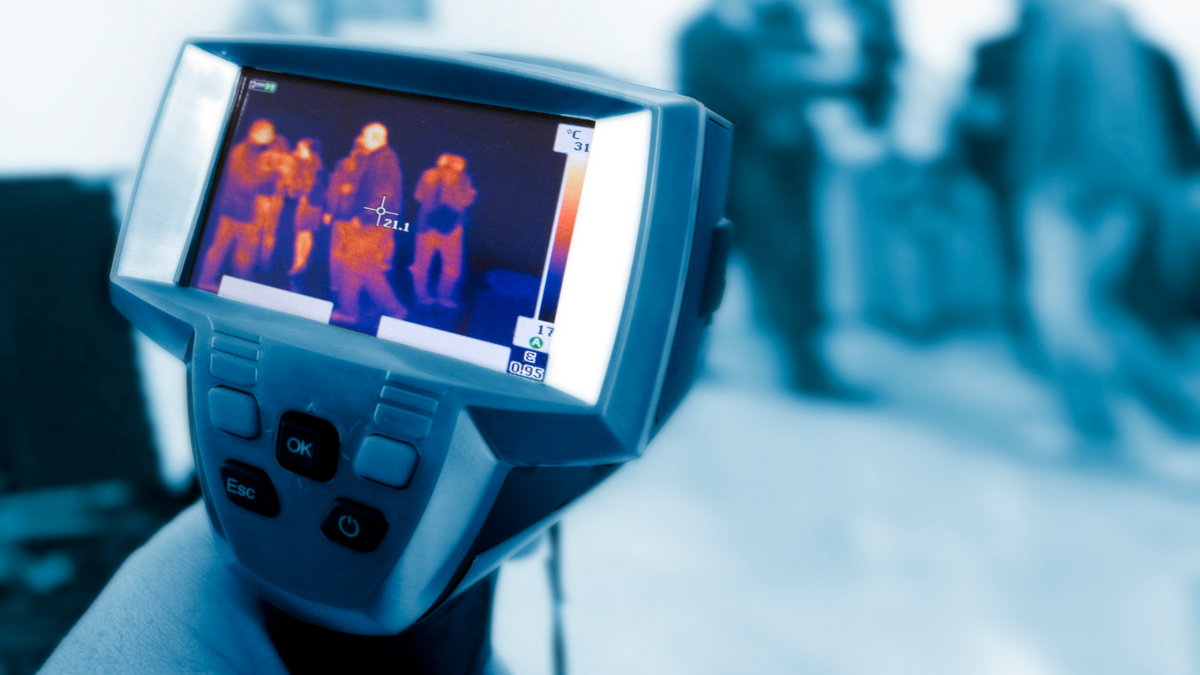COVID-19 has benefited something: The Smart Thermal Camera

Organizations are eager to resume business operations as the world adjusts to the novel Coronavirus (COVID-19) pandemic. In addition to personal protective equipment (PPE) now required for medical professionals and the general public, many tech devices have also evolved in order to help prevent COVID-19’s spread, such as smart thermal cameras.
Physical security components, such as infrared temperature sensors, serve as reliable diagnostic tools for detecting elevated body temperatures associated with infection.
Thermography cannot diagnose or prevent COVID-19. In addition, it may be able to identify those who are feeling ill and control a potential outbreak.
Smart Thermal Camera
The smart thermal camera is a device that converts thermal energy (heat) into visible light in order to analyze a particular object or scene. Smart Thermal imaging is a process that produces a still image called a thermogram. Smart Thermal cameras capture and display images captured by thermal sensors on a screen. Depending on the imaging method used, the images can guide immediate diagnosis or process through specialized software for closer examination, analysis, and report generation. The Smart Thermal Camera takes measuring temperature to a whole new level by allowing people to see the temperature differences between surfaces rather than just getting a number for them.
What does a smart thermal camera do?
Smart thermal cameras detect heat radiating from a body and estimate its core temperature by measuring radiant energy. These cameras are highly effective in following smoldering embers and searching for individuals in need of assistance.
Temperature Measurement
A smart thermal camera and its associated software allow images to be captured and analyzed immediately.
It is common for human bodies and even inanimate objects to absorb, reflect, and transmit heat and cold. In contrast to infrared or non-contact thermometers, handheld or mounted thermal imaging cameras hold at a distance to detect an individual’s body temperature.
These protocols assist in determining such measurements:
- Employees are monitored remotely through various screening procedures.
- A trained security professional can identify temperatures of more than 100 degrees based on the color variations seen on the camera screen. According to the Institute of Electrical and Electronics Engineers, the accuracy is within +/- 0.5 degrees Celsius.
- Temperatures are higher in warmer tones like red, orange, and yellow. In contrast, cooler temperatures appear purple or blue.
- A green temperature reading indicates room temperature.
- In cases where the reading is high, they are moved to a separate area so healthcare professionals can conduct additional screening.
Types of Smart Thermal Camera
Smart thermal cameras are available in various types. Handheld and mounted models are most common in fever detection. They provide easy user access to information.
Handheld: Thermal and optical imaging are available for enhanced viewing on this model. Airports, office buildings, and other public areas use these to perform quick, individual spot checks. In addition, the camera can record video and capture images. The system alerts the user when elevated readings are detected or the settings do not match the customized alarm. Bluetooth and Wi-Fi capabilities allow the cameras to be paired with any desktop or mobile device and mounted on a tripod.
Mounted: Using them, one can scan large crowds indoors and outdoors when mounted on a tripod or wall. It is helpful for parking garages, construction sites, and stadiums. Night vision is also available in these cameras.
Smart Thermal Camera and COVID-19
When used correctly, smart thermal camera systems can accurately identify a person’s surface skin temperature without that person being physically present. Other methods for measuring temperature (such as non-contact infrared thermometers or oral thermometers) require closer proximity or contact.
Astute Analytica indicates that the global smart thermal camera market is forecast to grow at a compound annual growth rate (CAGR) of 8.2% from 2021-2027. The growing use of thermal cameras in various applications, including surveillance, defense, monitoring, and temperature measurement, is significantly driving the market.
Smart thermal imaging cannot establish whether a person possesses COVID-19 definitively because, among other reasons, a person with COVID-19 may not have a fever. It is necessary to perform a diagnostic test in order to determine whether the patient has COVID-19.
Using a smart thermal camera system to take the temperature of several people simultaneously does not prove to be accurate. It is crucial that these systems are set up correctly and used and that the person assess is adequately trained.
Food and Drug Association’s Enforcement Policy for Tele thermographic Systems During the Coronavirus Disease 2019 (COVID-19) Public Health Emergency guidance aims to facilitate the availability of thermometers and reduce the risk of thermometer shortages during the public health emergency. During the COVID-19 public health emergency, the guide provides recommendations regarding smart thermal systems intended for medical use during life-threatening situations and establishing an enforcement policy for such systems.
Benefits of Smart Thermal Camera
- Persons handling thermal imaging systems do not have to be physically close to those they are evaluating. There is a possibility that the person who uses the smart thermal camera is in another room or area.
- Smart Thermal Camera may calculate surface skin temperature more quickly than forehead or oral (mouth) thermometers, which require proximity and physical contact.
- The smart thermal camera can accurately measure the surface skin temperature when used correctly.
Limitation of Smart Thermal Camera
It may be a good idea to use these systems to measure an individual’s temperature to triage them in high throughput areas (such as airports, businesses, and sporting events). However, the devices are ineffective when used to measure the temperature of multiple individuals at once.
Systems that measure skin temperature are generally less accurate than oral thermometers. It is, therefore, crucial to correct the differences in skin temperature measurements using thermal imaging systems.
A smart thermal camera is effective only when:
- The systems function in the right environment or location.
- Installation and operation have taken place correctly.
- A preparation manual is available to the person undergoing assessment.
- Operators receive proper training to use thermal imaging.
A COVID-19 outbreak has been a challenge in one form or another for almost all industries. The sudden rise in body temperature is one of the first signs of a Coronavirus infection, and the need for rapid temperature detection prompted the introduction of smart thermal cameras. The coronavirus epicenter of China used drones with thermal cameras to detect potentially infected people by measuring their body temperature. In recent years, handheld thermal cameras have become increasingly popular for monitoring the body temperatures of tourists and employees. It has resulted in a sudden increase in the smart thermal camera market and is expected to continue to rise.
Author’s bio
Emma is a freelance writer and content strategist who offers to ghostwrite, blogging and copywriting services. She has a keen interest in content marketing with a hold on social media management and market research. With more than five years of experience in writing for different domains, currently, she is exploring a new area of interest in “Information Technology”. Pitch her out to discuss interesting and niche IT domains that are blooming in integration with modern technologies.

